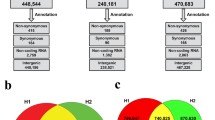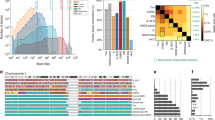Abstract
The goal of the Human Genome Project (HGP) is to determine a complete and high-quality sequence of the human genome. China, as one of the six member states, takes a region between 3pter and D3S3397 of the human chromosome 3 as its share of this historic project, referred as “Beijing Region”. The complete sequence of this region comprises of 17.4 megabasepairs (Mb) with an average GC content of 42% and an average recombination rate of 2.14 cM/Mb. Within Beijing Region, 122 known and 20 novel genes are identified, as well as 42607 single nucleotide polymorphisms (SNPs). Comprehensive analyses also reveal: (i) gene density and GC-content of Beijing Region are in agreement with human cytogenetic maps, i.e. G-minus bands are GC-rich and of a high gene density, whereas G-plus bands are GC-poor and of a relatively low gene density; (ii) the average recombination rate within Beijing Region is relatively high compared with other regions of chromosome 3, with the highest recombination rate of 6.06 cM/Mb in the subtelomeric area; (iii) it is most likely that a large gene, associated with the mammary gland, may reside in the 1.1 Mb gene-poor area near the telomere; (iv) many disease-related genes are genetically mapped to Beijing Region, including those associated with cancers and metabolic syndromes. All make Beijing Region an important target for in-depth molecular investigations with a purpose of medical applications.
Similar content being viewed by others
References
The International Human Genome Sequencing Consortium, Initial sequencing and analysis of the human genome, Nature, 2001, 409: 860–921.
Ewing, B., Green, P., Base-calling of automated sequencer traces using phred. II Error probabilities, Genome Res., 1998, 8: 186–194.
Ewing, B., Hillier, L. M., Wendl, C. et al., Base-calling of automated sequencer traces using phred. I. Accuracy assessment, Genome Res., 1998, 8: 175–185.
Gordon, D., Abajian, C., Green, P., Consed: A graphical tool for sequence finishing, Genome Res., 1998, 8: 195–202.
Benson, G., Tandem repeats finder: A program to analyze DNA sequences, Nucleic Acids Res., 1999, 27: 573–580.
Pruitt, K. D., Maglott, D. R., RefSeq and LocusLink: NCBI gene-centered resources, Nucleic Acids Res., 2001, 29: 137–140.
Imanishi, T., Itoh, T., Suzuki, Y. et al., Integrative Annotation of 21, 037 Human Genes Validated by Full-Length cDNA Clones, PLoS Bio., 2004, 2(6): e162.
Kent, W. J., BLAT—The BLAST-Like Alignment Tool, Genome Res., 2002, 12:656–664.
Salamov, A. A., Solovyev, V. V., Ab initio gene finding in Drosophila genomic DNA, Genome Res., 2000, 10: 516–522.
Boeckmann, B., Bairoch, A., Apweiler, R. et al., The SWISS-PROT protein knowledgebase and its supplement TrEMBL in 2003, Nucleic Acids Res., 2003, 31: 365–370.
Zdobnov, E. M., Apweiler, Rolf, InterProScan—An integration platform for the signature-recognition methods in InterPro, Bioinformatics, 2001, 17: 847–848.
Lowe, T. M., Eddy, S. R., tRNAscan-SE: A program for improved detection of transfer RNA genes in genomic sequence, Nucleic Acids Res., 1997, 25: 955–964.
Griffiths-Jones, S., Bateman, A., Marshall, M., et al., An RNA family database, Nucleic Acids Res., 2003, 31:439–441.
Griffiths-Jones, S., The microRNA Registry, Nucleic Acids Res., 2004, 32: 109–111.
Ambros, V., Bartel, B., Bartel, D. P., A uniform system for microRNA annotation, RNA, 2003, 9: 277–279.
Schwartz, S., Kent, W. J., Smit, A. et al., Human-mouse alignments with BLASTZ, Genome Res., 2003, 13: 103–107.
Felsenfeld, A., Peterson, J., Schloss, J. et al., Assessing the quality of the DNA sequence from the Human Genome Project, Genome Res., 1999, 9: 1–4.
Patel, A., Rochelle, J. M., Jones, J. M. et al., Mapping of the taurine transporter gene to mouse chromosome 6 and to the short arm of human chromosome 3, Genomics, 1995, 25: 314–317.
Heilig, R., Eckenberg, R., Petit, J. L. et al., The DNA sequence and analysis of human chromosome 14, Nature, 2003, 421: 601–607.
Woolfe, A., Goodson, M., Goode, D. K. et al., Highly conserved non-coding sequences are associated with vertebrate development, PLoS Biol., 2005, 3: e7.
Deloukas, P., Matthews, L. H., Ashurst, J. et al., The DNA sequence and comparative analysis of human chromosome 20, Nature, 2001, 414: 865–871.
Dunham, I., Shimizu, N., Roe, B. A. et al., The DNA sequence of human chromosome 22, Nature, 1999, 402: 489–495.
Mironov, A. A., Fickett, J. W., Gelfand, M. S., Frequent alternative splicing of human genes, Genome Res., 1999, 9: 1288–1293.
The Gene Ontology Consortium, Gene Ontology: Tool for the unification of biology. Nat. Genet., 2000, 25: 25–29.
Gardiner, K., Human genome organization, Curr. Opin. Genet., 1995, 5:315–322.
Kruglyak, S., Durrett, R. T., Schug, M. D. et al., Equilibrium distributions of microsatellite repeat length resulting from a balance between slippage events and point mutations, Proc. Natl. Acad. Sci. USA, 1998, 95: 10774–10778.
The International HapMap Consortium, The international Hap-Map project, Nature, 2003, 426: 789–796.
Schwartz, S., Kent, W. J., Smit, A. et al., Human-mouse alignments with BLASTZ, Genome Res., 2003, 13: 103–107.
Riethman, H. C., Moyzis, R. K., Meyne, J. et al., Cloning human telomeric DNA fragments into Saccharomyces cerevisiae using a yeast-artificial-chromosome vector, Proc. Natl. Acad. Sci. USA, 1989, 86:6240–6244.
Riethman, H., Ambrosini, A., Castaneda, C. et al., Mapping and initial analysis of human subtelomeric sequence assemblies, Genome Res., 2004, 14: 18–28.
Purrello, M., Alhadeff, B., Whittington, E. et al., Comparison of cytologic and genetic distances between long arm subtelomeric markers of human autosome 14 suggests uneven distribution of crossing-over, Cytogenet. Cell Genet., 1987, 44: 32–40.
Mohrenweiser, H. W., Tsujimoto, S., Gordon, L. et al., Regions of sex-specific hypo and hyper-recombination identified through integration of 180 genetic markers into the metric physical map of human chromosome 19, Genomics, 1998, 472: 153–162.
Broman, K. W., Murray, J.C., Sheffield, V. C. et al., Comprehensive human genetic maps: Individual and sex-specific variation in recombination, Am. J. Hum. Genet., 1998, 63: 861–869.
Dib, C., Faure, S., Fizames, C. et al., A comprehensive genetic map of the human genome based on 5,264 microsatellites, Nature, 1996, 380:152–154.
Gerton, J. L., DeRisi, J., Shroff, R. et al., Global mapping of meiotic recombination hotspots and coldspots in the yeast Saccharomyces cerevisiae, Proc. Natl. Acad. Sci. USA, 2000, 97: 11383–11390.
Wang, J., Li, S. T., Zhang, Y. et al., Vertebrate gene predictions and the problem of large genes, Nature, 2003, 4: 741–749.
Burge, C., Karlin, S., Prediction of complete gene structures in human genomic DNA, J. Mol. Biol., 1997, 268: 78–94.
Birn, E., Clamp, M., Durbin, R., GeneWise and Genomewise, Genome Res., 2004, 14: 988–995.
Fortna, A., Gardiner, K., Genomic sequence analysis tools: A user’s guide, Trends Genet., 2001, 17: 158–164.
International Human Genome Sequencing Consortium, Finishing the euchromatic sequence of the human genome, Nature, 2004, 431:931–945.
Wong, G. K., Passey, D. A., Yu, J., Most of the human genome is transcribed, Genome Res., 2001, 11: 1975–1977.
Wong, G. K., Passey, D. A., Huang, Y. et al., Is “junk” DNA mostly intron DNA? Genome Res., 2000, 10: 1672–1678.
Venkatesh, B., Gilligan, P., Brenner, S., Fugu: A compact vertebrate reference genome, FEBS Lett., 2000, 476: 3–7.
Venter, J. C., Adams, M. D., Myers, E. W. et al., The sequence of the human genome, Science, 2001, 291: 1304–1351.
Wu, Q., Dong, W., Qi, X., Genomic Structure of Metabotropic glutamate receptor 7 and comparison of genomic structures of extracellular domains of mGluR family, Chinese Science Bulletin, 2002, 47: 1330–1336.
Makoff, A., Pilling, C., Harrington, K. et al., Human metabotropic glutamate receptor type 7: Molecular cloning and mRNA distribution in the CNS, Brain Res. Mol. Brain Res., 1996, 40: 165–170.
Phillips, T., Makoff, A., Murrison, E. et al., Immunohistochemical localisation of mGluR7 protein in the rodent and human cerebellar cortex using subtype specific antibodies, Brain Res. Mol. Brain Res., 1998, 57:132–141.
Monaghan, D. T., Bridges, R. J., Cotman, C. W., The excitatory amino acid receptors: Their classes, pharmacology, and distinct properties in the function of the central nervous system, Annu. Rev. Pharmacol. Toxicol., 1989, 29: 365–402.
Huang, F., Shi, L. J., Heng, H. H. et al., Assignment of the human GABA transporter gene (GABATHG) locus to chromosome 3p24-p25, Genomics, 1995, 29: 302–304.
Borden, L. A., Dhar, T. G., Smith, K. E. et al., Cloning of the human homologue of the GABA transporter GAT-3 and identification of a novel inhibitor with selectivity for this site, Receptors Channels, 1994, 2: 207–213.
Huebner, K., Tumor suppressors on 3p: A neoclassic quartet, Proc. Natl. Acad. Sci. USA, 2001, 98: 14763–14765.
Kondo, K., William, G., Kaelin, J. R., The von Hippel-Lindau tumor suppressor gene, Exp. Cell Res., 2001, 264: 117–125.
Friedrich, C. A., Von Hippel-Lindau syndrome. A pleomorphic condition, Cancer, 1999, 86: 2478–2482.
Duan, D. R., Pause, A., Burgess, W. H. et al., Inhibition of transcription elongation by the VHL tumor suppressor protein, Science, 1995, 269: 1402–1406.
Kibel, A., Iliopoulos, O., DeCaprio, J. A., et al., Binding of the von Hippel-Lindau tumor suppressor protein to Elongin B and C, Science, 1995, 269: 1444–1446.
Gnarra, J. R., Zhou, S., Merrill, M. J., et al., Post-transcriptional regulation of vascular endothelial growth factor mRNA by the product of the VHL tumor suppressor gene, Proc. Natl. Acad. Sci. USA, 1996, 93: 10589–10594.
Iliopoulos, O., Levy, A. P., Jiang, C., et al., Negative regulation of hypoxia-inducible genes by the von Hippel-Lindau protein, Proc. Natl. Acad. Sci. USA, 1996, 93: 10595–10599.
Pause, A., Lee, S., Lonergan, K. M. et al., The von Hippel-Lindau tumor suppressor gene is required for cell cycle exit upon serum withdrawal, Proc. Natl. Acad. Sci. USA, 1998, 95: 993–998.
Ohh, M., Yauch, R. L., Lonergan, K. M. et al., The von Hippel-Lindau tumor suppressor protein is required for proper assembly of an extracellular fibronectin matrix, Mol. Cell, 1998, 1: 959:968.
Kamura, T., Koepp, D. M., Conrad, M. N. et al., Rbx1, a component of the VHL tumor suppressor complex and SCF ubiquitin ligase, Science, 1999, 284: 657–661.
Timmers, C., Taniguchi, T., Hejna, J. et al., Positional cloning of a novel Fanconi anemia gene, FANCD2, Mol. Cell, 2001, 7–241:248.
Garcia-Higuera, I., Taniguchi, T., Ganesan, S. et al., Interaction of the Fanconi anemia proteins and BRCA1 in a common pathway, Mol. Cell, 2001, 7: 249–262.
Galbiati, F., Volonte, D., Minetti, C. et al., Phenotypic behavior of caveolin-3 mutations that cause autosomal dominant limb girdle muscular dystrophy (LGMD-1C). Retention of LGMD-1C caveolin-3 mutants within the golgi complex, J. Biol. Chem., 1999, 274: 25632–25641.
Wang, M., Liu, Y. E., Greene, J. et al., Inhibition of tumor growth and metastasis of human breast cancer cells transfected with tissue inhibitor of metalloproteinase 4, Oncogene, 1997, 14: 2767–2774.
Collins, F. S., Positional cloning moves from perditional to traditional, Nat. Genet., 1995, 9: 347–350.
Drumheller, T., McGillivray, B. C., Behrner, D. et al., Precise localisation of 3p25 breakpoints in four patients with the 3p-syndrome, J. Med. Genet., 1996, 33: 842–847.
Angeloni, D., Lindor, N. M., Pack, S. et al., CALL gene is haploinsufficient in a 3p-syndrome patient, Am. J. Med. Genet., 1999, 86:482–485.
Dan, M., Niebuhr, A., Zhang, X. X., Critical region for cri-du-chat syndrome is located in the 5p15.2, a region flanked by DNA markers D5S713 and D5S18, Chinese Journal of Medical Genetics, 1997, 14:263–267.
Church, D. M., Bengtsson, U., Nielsen, K. V. et al., Molecular definition of deletions of different segments of distal 5p that result in distinct phenotypic features, Am. J. Hum. Genet., 1995, 56: 1162–1172.
Author information
Authors and Affiliations
Consortia
Additional information
A full list of authors appears at the end of this paper
Rights and permissions
About this article
Cite this article
The Chinese Human Genome Sequencing Consortium. “Beijing Region” (3pter-D3S3397) of the Human Genome: Complete sequence and analysis. Sci. China Ser. C.-Life Sci. 48, 311–329 (2005). https://doi.org/10.1360/062005-173
Received:
Issue Date:
DOI: https://doi.org/10.1360/062005-173




